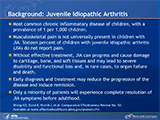- Home
- Slides
- Home
- Tools and Resources
- Research Summaries for Consumers, Clinicians, and Policymakers
- Search for Research Summaries, Reviews, and Reports
- Research Available for Comment
- Submit a Suggestion for Research
- Submit Scientific Information Packets
- Comparative Effectiveness Research Grant and ARRA Awards
- News and Announcements
- What Is Comparative Effectiveness Research
- Who Is Involved in the Effective Health Care Program
- What Is the Effective Health Care Program
Slides
Slides: 1–12 of 71
Background: Musculoskeletal Pain
Keywords: musculoskeletal pain | children | clinical characteristics | stiffness | joint swelling | malar rash | cytopenia | pediatric rheumatic condition
Background: Juvenile Idiopathic Arthritis
Comparative Effectiveness Review: Outcomes of Interest
Evidence on the Comparative Effectiveness Regarding Quality of Life and Adverse Events
Studies Regarding Quality of Life and Adverse Events: IMRT vs. 3DCRT
Evidence on the Comparative Effectiveness Regarding Quality of Life and Adverse Events: IMRT vs. 2DRT
Studies Regarding Late Xerostomia: IMRT vs. 2DRT
Evidence on the Comparative Effectiveness Regarding Quality of Life and Adverse Events: 3DCRT vs. 2DRT
Findings of the Comparative Effectiveness Review: Medication (3 of 3)
Overview of Adverse Events and Side Effects
Presentation: Comparing Medications for Adults With Type 2 Diabetes
Other Adverse Events and Side Effects: Comparisons of Monotherapies
Presentation: Comparing Medications for Adults With Type 2 Diabetes
Keywords: adverse events | congestive heart failure | fractures | lactic acidosis | monotherapy | liver injury
Your slide tray is being processed.


 E-mail Updates
E-mail Updates










